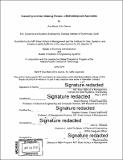| dc.contributor.advisor | Duane Boning and Stephen Graves. | en_US |
| dc.contributor.author | Garcia, Ana Maria Ortiz | en_US |
| dc.contributor.other | Leaders for Global Operations Program. | en_US |
| dc.date.accessioned | 2016-09-27T15:15:13Z | |
| dc.date.available | 2016-09-27T15:15:13Z | |
| dc.date.copyright | 2016 | en_US |
| dc.date.issued | 2016 | en_US |
| dc.identifier.uri | http://hdl.handle.net/1721.1/104399 | |
| dc.description | Thesis: M.B.A., Massachusetts Institute of Technology, Sloan School of Management, 2016. In conjunction with the Leaders for Global Operations Program at MIT. | en_US |
| dc.description | Thesis: S.M. in Engineering Systems, Massachusetts Institute of Technology, School of Engineering, Institute for Data, Systems, and Society, 2016. In conjunction with the Leaders for Global Operations Program at MIT. | en_US |
| dc.description | Cataloged from PDF version of thesis. | en_US |
| dc.description | Includes bibliographical references (page 74). | en_US |
| dc.description.abstract | This work considers how inventory ordering policies can distort the demand signal as it moves up the supply chain, magnifying the impact of the bullwhip effect. We define an inventory ordering policy as a set of rules that govern the process of issuing and updating a forecast of product order quantities over several periods. This forecast is estimated by a retailer and shared with a supplier to drive production, shipping, procurement and capacity planning decisions. In this context we evaluate the hypothesis that key supply chain metrics such as order quantity variability and shortage/surplus of inventory can be improved by changing the ordering policy. Two ordering policies are recommended for the particular use case presented, which is in the context of Verizon Wireline's Demand and Supply Planning group. The first policy is a radical change from existing contractual frameworks that can result in 38% reduction of order quantity variability and a 95% reduction in percentage of time with an inventory surplus. A second, less radical, policy results in a 36% reduction of order quantity variability and a 57% reduction in percentage of time with an inventory surplus. This work describes elements of alternate ordering policies including business rules and contractual elements. In the presented analysis we show that a long-term minimum commitment base, demand signal dampening, and the introduction of additional flexibility in the short-term are effective in reducing order quantity variability and improving inventory position. We caution, however, that providing more flexibility in the short term will require suppliers to hold a buffer of inventory to absorb changes in order quantities that occur while the product is being shipped from factory to retailer. Furthermore, we present the application of discrete event simulation to evaluate the performance of the policies under consideration, incorporating historical forecasts and actual demand. This methodology is broadly applicable to the analysis of supply chain decision rules as they relate to supply chain metrics. We propose several metrics to measure order quantity variability, inventory position, and distribution of financial risk and demonstrate a methodology to assess policies in relation to each other to facilitate policy selection. | en_US |
| dc.description.statementofresponsibility | by Ana Maria Ortiz Garcia. | en_US |
| dc.format.extent | 74 pages | en_US |
| dc.language.iso | eng | en_US |
| dc.publisher | Massachusetts Institute of Technology | en_US |
| dc.rights | M.I.T. theses are protected by copyright. They may be viewed from this source for any purpose, but reproduction or distribution in any format is prohibited without written permission. See provided URL for inquiries about permission. | en_US |
| dc.rights.uri | http://dspace.mit.edu/handle/1721.1/7582 | en_US |
| dc.subject | Sloan School of Management. | en_US |
| dc.subject | Institute for Data, Systems, and Society. | en_US |
| dc.subject | Engineering Systems Division. | en_US |
| dc.subject | Leaders for Global Operations Program. | en_US |
| dc.title | Evaluating inventory ordering policies : a methodology and application | en_US |
| dc.type | Thesis | en_US |
| dc.description.degree | M.B.A. | en_US |
| dc.description.degree | S.M. in Engineering Systems | en_US |
| dc.contributor.department | Leaders for Global Operations Program at MIT | en_US |
| dc.contributor.department | Massachusetts Institute of Technology. Engineering Systems Division | |
| dc.contributor.department | Massachusetts Institute of Technology. Institute for Data, Systems, and Society | |
| dc.contributor.department | Sloan School of Management | |
| dc.identifier.oclc | 958269731 | en_US |
